Thermador TFL18IR800, ZOME36ABS Installation Manual
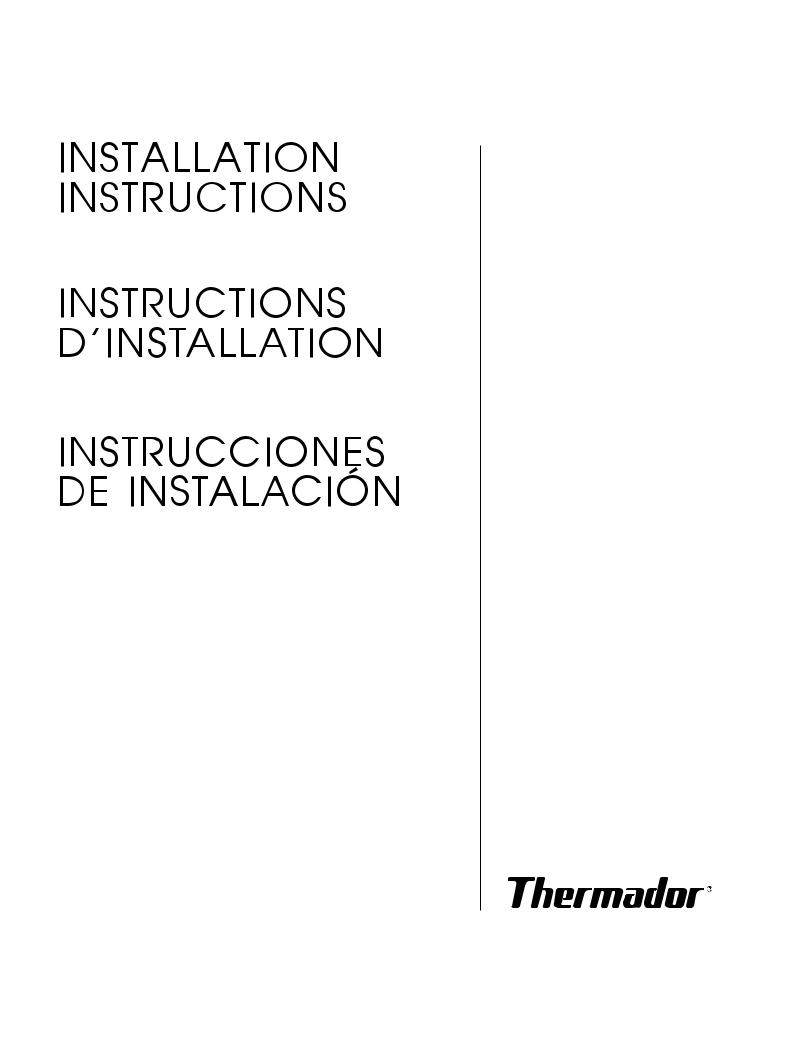
T18....
T24....
T30....
9000861715
2
INSTALLATION INSTRUCTIONS ............................................................................... |
4 |
INSTRUCTIONS D’INSTALLATION ............................................................................ |
36 |
INSTRUCCIONES DE INSTALACIÓN......................................................................... |
70 |
3

Table of Contents |
|
Safety and warning information ......................... |
5 |
Installation options .............................................. |
6 |
Individual appliance .................................................. |
6 |
Side-by-Side ................................................................ |
6 |
Individual appliances with partition ........................ |
6 |
Individual appliance at the end of the kitchen ..... |
6 |
Installation ............................................................ |
7 |
Installation room.......................................................... |
7 |
Stable installation ...................................................... |
7 |
Installation enclosure ................................................ |
7 |
Furniture ...................................................................... |
7 |
Floor ............................................................................. |
7 |
Aligning the appliance .............................................. |
7 |
Connecting the power ......................................... |
8 |
Connecting the water .......................................... |
8 |
Dimensions of the installation niche ................. |
9 |
Required accessories and tools ......................... |
10 |
Supplied accessories ............................................... |
10 |
Optional accessories ................................................ |
10 |
Other required accessories ..................................... |
10 |
Miscellaneous ............................................................ |
10 |
Tools ............................................................................ |
10 |
Installation instructions ...................................... |
11 |
1.Checking the installation
|
enclosure .............................................. |
11 |
2. |
Removing the packaging .................. |
11 |
3. |
Transport of the appliance ................ |
12 |
4. |
Installation preparation ...................... |
12 |
5. |
Special installation .............................. |
12 |
1. |
Attaching the anti-tip-brackets .......... |
13 |
2. |
Attaching an alternative |
|
|
anti-tip-device ....................................... |
14 |
3. |
Attaching an edge protection ........... |
14 |
4. |
Attaching the fastening sheets |
|
|
(lateral) ................................................... |
14 |
1. |
Pushing the appliance into |
|
|
the installation enclosure ................... |
15 |
2. |
Aligning the appliance in |
|
|
the installation enclosure ................... |
16 |
3. |
Attaching the appliance to |
|
|
the installation enclosure ................... |
16 |
1. |
Attaching the toe kick panel ............. |
18 |
2. |
Aligning the base panel ..................... |
18 |
3. |
Switching the appliance ON ............. |
19 |
4. |
Preparing the door panels ................ |
19 |
5. |
Loading the appliance door .............. |
19 |
6. |
Removing the installation |
|
|
support part .......................................... |
19 |
7. |
Attaching the adjusting rail |
|
|
to the door panel ................................ |
20 |
8. |
Attaching the fixation strips |
|
|
to the door panel ................................ |
20 |
9. |
Attaching the door panel ................... |
21 |
10. |
Attaching the lower bracket .............. |
22 |
11. |
Attaching the strips ............................. |
23 |
12. |
Mounting the air seperator ................ |
23 |
13. |
Adjusting the door spring .................. |
24 |
Special installation .............................................. |
25 |
|
Changing over the door hinges ............... |
25 |
|
Removing/changing over |
|
|
the sealing mat ............................................ |
28 |
|
Side-by-Side installation ............................. |
28 |
|
Preparing to connect the water ................ |
31 |
|
Connecting the water to the appliance ..... |
31 |
|
Aligning the ice-water dispenser .............. |
32 |
|
Attaching the cover strips ......................... |
33 |
|
Adjusting the door opening angle ........... |
34 |
|
4
,Safety and warning information
These mounting instructions are designed to help you install your new appliance.
The manufacturer cannot be held liable for mounting which has been improperly carried out. We recommend that you allow a qualified specialist to set up and switch the appliance on for the first time.
Following all information and keeping to the instructions are preconditions for mounting and switching the appliance on safely for the first time.
Keep the mounting instructions safe for use later on.
Before setting up and switching the appliance on for the first time, read the mounting instructions fully and thoroughly.
, WARNING
These appliances are top-heavy and must be secured to prevent the possibility of tipping forward.
Anti-tip protection is required.
Keep doors closed until the appliance is completely installed and secured per installation instructions.
Due to the weight and size of this appliance, and to reduce the risk of personal injury or damage to the product – TWO PEOPLE ARE REQUIRED FOR PROPER INSTALLATION.
This appliance must be properly grounded. See the section on “Connecting the power”.
Use this appliance only for its intended purpose.
Immediately repair or replace electric service cords that become frayed or damaged.
Unplug the appliance or switch off the fuse before cleaning or making repairs.
Repairs should be made by a qualified service technician.
IMPORTANT
Save these instructions for local inspector's use. Observe all governing codes and ordinances.
Note to Installer – Be sure to leave these instructions with the Consumer.
Note to Consumer – Keep these instructions with your Owner's Manual for future reference.
General
These installation instructions are intended for use by qualified installers. All connections for water, electrical power and grounding must comply with local codes and ordinances and be made by licensed personnel when required. In the absence of a local code:
In the U.S.A., in accordance with the National Electric Code, ANSI/NFPA70 – latest edition/State and Municipal codes and/or local codes.
In Canada, in accordance with the Canadian Electric Code C22.1 – latest edition/Provincial and Municipal codes and/or local codes.
Definitions
,WARNING
This indicates that death or serious injuries may occur as a result of not observing this warning.
,CAUTION
This indicates that minor or moderate injuries or damage may occur as a result of not observing this warning.
Note:
This is used to draw the user's attention to something in particular.
, CAUTION
Installation of this appliance requires basic mechanical, carpentry and plumbing skills.
Proper installation is the responsibility of the installer.
Product failure due to improper installation is not covered under the Appliance Warranty.
See the Owner's Manual for warranty information.
5
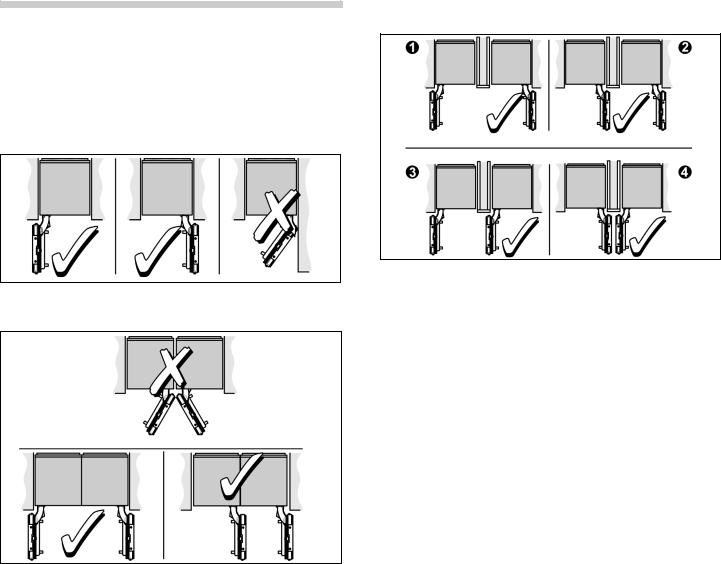
Installation options
There are many different installation options. These are limited only by the design of the kitchen. See also “Kitchen Design Quick Reference”.
Individual appliance
Side-by-Side
If two appliances are set up next to each other, a sealing kit for Side-by-Side combination should be used in order to guarantee a stable connection.
For further information see section “Required accessories and tools”.
Individual appliances with partition
When dimensioning the partition for model 4, note the thickness of the door panels to prevent damage if the doors are opened at the same time.
Use the Heater Kit for Side-by-Side Installation if the gap between the appliances is less
than 6" (160 mm).
See the section on “Required accessories and tools/Optional accessories”.
Minimum thickness of the partition 5/8" (16 mm).
Individual appliance at the end of the kitchen
If one side of the appliance is visible, a side panel must be used.
The side panel must be connected firmly to the wall, the floor and overhead cabinet/fixtures before the appliance is placed in the installation niche.
The dimensions of the side panel are taken from the opposite installation niche wall. During installation ensure that the installation niche is square and the proper size.
6

Installation
,WARNING
Do not install the appliance:
outdoors,
in an environment with dripping water,
in rooms which are less than 32 °F (0 °C).
A fully-loaded appliance is very heavy. Refrigerator 24" approx. 890 Ibs/400 kg Refrigerator 30" approx. 1110 Ibs/500 kg Freezer 18" approx. 560 Ibs/250 kg* Freezer 24" approx. 780 Ibs/350 kg* Freezer 30" approx. 950 Ibs/425 kg* Wine unit 18" approx. 550 Ibs/245 kg Wine unit 24" approx. 694 Ibs/310 kg (* without Water Dispenser)
Installation room
The appliance should be installed in a dry, well ventilated space.
The location should not be exposed to the direct sunlight and should not lie next to a source of heat such as a cooker or a radiator etc. If installation next to a source of heat cannot be avoided, either a suitable insulating plate should be used or you should keep to the following minimum distances:
11/4" (3 cm) to electric or gas cookers,
1113/16" (30 cm) to an oil-fired or solid-fuel cooker.
Climatic classes
The climate class can be found on the rating plate. The climate class indicates within which ambient temperatures the appliance can be operated.
Climatic class |
Permitted ambient temperature |
|
|
|
|
SN |
50 |
°F to 90 °F (+10 °C to 32 °C) |
N |
61 |
°F to 90 °F (+16 °C to 32 °C) |
ST |
61 |
°F to 100 °F (+16 °C to 38 °C) |
T |
61 |
°F to 110 °F (+16 °C to 43 °C) |
|
|
|
Stable installation
The appliance is very heavy and has a tendency to tilt forwards when the appliance door is opened.
The appliance must not be switched on until there is no possibility of the appliance tilting over.
The safest method of installing the appliance in a stable position is to use the supplied anti-tilt brackets.
If the installation niche is adequately stable and the appliance can be attached securely to the upper and side walls of the niche, it may be possible to dispense with the anti-tilt brackets. A prerequisite for this is always a firm connection between the niche and back wall!
In the case of doubt, the help of architect or specialist builder should be enlisted.
Installation niche
It is important to keep to the stated dimensions of the installation niche with a view to trouble-free fitting, and the subsequent appearance of the kitchen furniture frontage.
Special care should be taken that the niche has right angles. The side walls should not exhibit areas that stick out, projections or unevenness.
You should determine the right angles of the installation niche with appropriate means, e.g. by measuring diagonally and by using a spirit level.
The side walls and the upper end of the installation niche must be at least 5/8" (16 mm) thick.
Furniture
The new appliance is screwed down tightly using parts of the cabinet and the upper cabinet.
Care should therefore be taken, that all upper cabinets to which something has been fastened are securely connected to the subsurface or wall by appropriate means.
The minimum thickness of the base should be a minimum of 19 mm.
Floor
The subsurface must be level and even in order to ensure that the appliance is securely installed and works correctly.
The subsurface must be made from a hard, non-flexible material.
The floor of the installation space must have the same height as the rest of the space.
On account of the weight of a fully-laden appliance, it is necessary to have a bearing subsurface. In the case of doubt, the help of architect or specialist builder should be enlisted.
Aligning the appliance
To ensure that the appliance functions correctly, it must be levelled properly.
If the appliance is not level, water may flow out of the ice maker, ice cubes may be irregular or the doors may not close properly.
7

Connecting the power
,WARNING
Avoid the risk of an electric shock!
Insert into a grounded 3-phase socket.
Never remove grounding phase. Do not use any adapters. Do not use any extension cables.
Non-compliance with these instructions may result in death, fire or an electric shock. Improper connection of the protective conductor may result in an electric shock. If you are in doubt whether the appliance has been grounded properly, have the appliance tested by a qualified electrician or service technician.
The socket must be near the appliance and also freely accessible following installation of the appliance.
The appliance complies with protection class I. Connect the appliance to 115 V/60 Hz alternating current via a correctly installed socket with protective conductor. The socket must be fused with a 10 to 16 A fuse.
The appliance comes with a UL registered 3-wire power cord. The appliance requires a 3-pole socket. Please observe the following table with regard to this:
Appliance |
Maximal load at one time |
|
|
Refrigerator 24" |
2.0 Ampere |
|
|
Refrigerator 30" |
2.0 Ampere |
|
|
Freezer 18" (*) |
3.5 Ampere |
|
|
Freezer 24" (*) |
4.0 Ampere |
|
|
Freezer 30" (*) |
4.5 Ampere |
|
|
Wine unit 18" |
2.0 Ampere |
|
|
Wine unit 24" |
2.0 Ampere |
|
|
(*) incl. IceMaker
Check on the rating plate whether the indicated voltage and current type correspond with the values of your power supply. The location of the rating plate can be found in the chapter entitled Customer service.
,WARNING
Never connect the appliance to electronic energy saver plugs. Our appliances can be used with mains and sine-controlled inverters. Mainscontrolled inverters are used for photovoltaic systems which are connected directly to the national grid. Sine-controlled inverters must be used for isolated applications (e.g. on ships or in mountain lodges) which are not connected directly to the national grid.
Connecting the water
,CAUTION
Only connect the appliance to drinking water!
The water may be connected only by a competent fitter according to the local regulations of the appropriate water supply company.
A cold water connection is necessary for operating the automatic ice maker. The water pressure must be between 25 and 120 p.s.i. (1,72 and 8,25 bar).
The installation must correspond to the local plumbing regulations.
A separate shut-off valve should be installed in the coldwater inflow. The shut-off valve should not be located behind the appliance. It is recommended that you mount the shut-off valve directly next to the appliance or at another place which is easily accessible. When installing the water connection, pay attention to the permissible installation area for the water mains.
For connection to the drinking water mains use only water pipes which are suitable for drinking water. Observe national regulations and the connection conditions of the local water supply companies.
When installing the water connection, observe the permitted installation areas for the pipe. For the permitted installation areas and dimensions see “Dimensions of the installation niche”.
Maximum outer diameter of the water pipe (without fittings): 3/8" (9.5 mm).
8
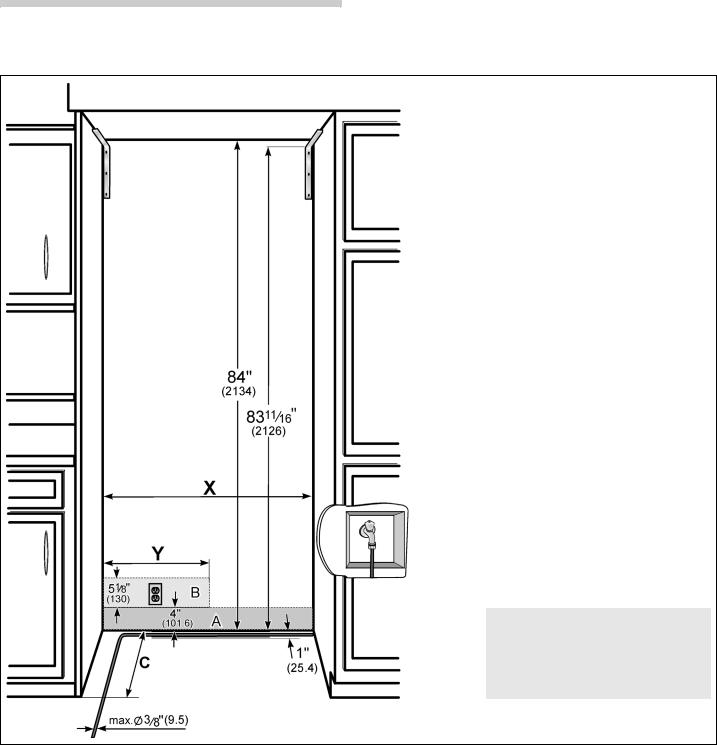
Dimensions of the installation niche
|
X |
Y |
|
|
18“ |
9“ |
|
|
(457 mm) |
(229 mm) |
|
|
24“ |
12“ |
|
|
(610 mm) |
(305 mm) |
|
|
30“ |
15“ |
|
|
(762 mm) |
(381 mm) |
|
|
|
|
|
IMPORTANT !
The side walls of the niche must be perfectly straight. The furniture return area has to be at least 4" (100 mm) deep.
Legend:
AArea for installation of the water connection
It is recommended the water-box be placed adjacent to the installation niche, so that it can be accessed for service without uninstalling the appliance. If this is not possible, place the recessed water box within the shaded area.
BArea for installation of the power connection
COpening depth of niche, depending on kitchen design C = 24" (610 mm) minimum
9
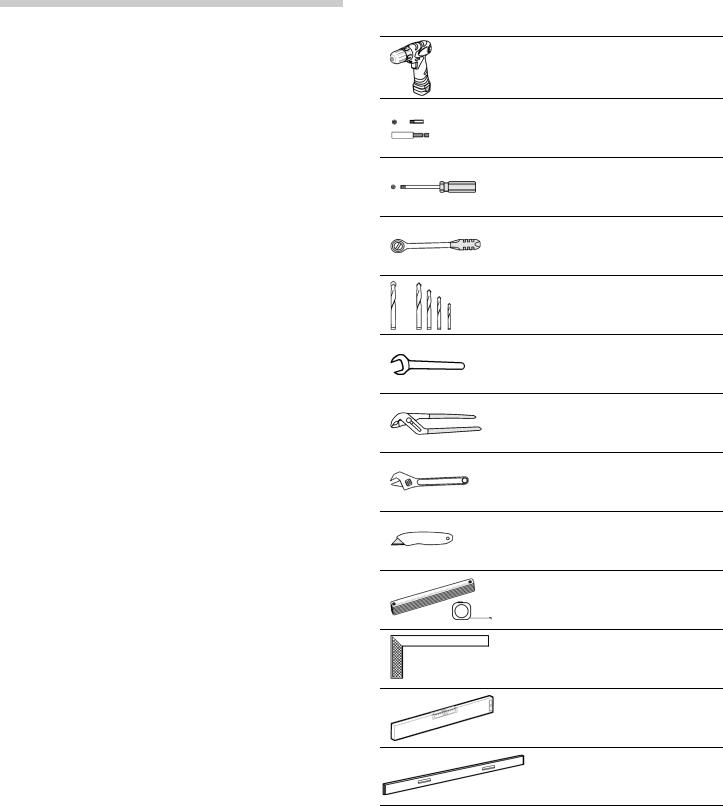
Tools
Required accessories and tools
Supplied accessories
Installation instructions
Operating instructions
Installation kit
Optional accessories
Sealing Kit for Side-by-Side Installation BSEALKIT10
For permanent connection of two individual appliances, e.g. Freezer next to Refrigerator.
Freedom Heater Kit for Side-by-Side Installation XHEATKIT10
If the gap between the appliances is less than 6" (160 mm).
Panel unification part (Metal strip) FPCONNTS10
For connection of two door panels. Can be used for standard height door panels without further preliminary work.
Other required accessories
Ice maker installation kit 1/4" OD copper line
For connecting appliances which require water, e.g. for an ice maker.
Maximum outer diameter of the water pipe (without fittings): 13/32" (10 mm).
Miscellaneous
Stepladder
Dolly, hand truck
Hammer drill for drilling holes in wall or floor
Bits according suitable for material and in different sizes
Wooden beam (cross section min. 3" x 4") as an alternative tip protection, length according to the width of the installation niche
Wooden screws in different sizes
Thin plywood sheet, particle board or cardboard to protect the floor from damage
Suitable material for covering and protecting furniture (e.g. protective sheets)
Adhesive tape
Note:
Before using, check whether the removed adhesive tape leaves adhesive residue on the work surfaces! Otherwise do not use on high-quality work surfaces.
Cordless screwdriver
Torx bit T20 + magnetic holder
Torx screwdriver T20
5/16" (8 mm) hex nut driver
Wood drills in different sizes
Open end wrench 1/2" (SW 13 mm)
Multigrip pliers
Adjustable wrench
Cutter with adjustable blade
Metal tape measure, folding rule
Square
Level, length 2' (60 cm) and 4' (1,2 m)
Level, min. 4' (1 ,2 m) long
10

Installation instructions
The following installation instructions describe the installation steps for various appliance types:
Refrigerator units
Freezer units
Freezer units with ice maker
Freezer units with ice-water dispenser
Wine storage units
Therefore the diagrams may be a general representation of your appliance.
Particular reference is made to special installation steps for individual appliance types.
1.Checking the installation niche
, CAUTION
Use the following check list for a safe and trouble free installation.
1.Check the floor.
See section on “Installation/Floor”.
2.Check the dimensions of the installation niche, see “Dimensions of the installation niche”.
3.Check that the installation niche is square.
4.Check location of the socket.
See section on “Connecting the power” and in the section on “Dimensions of the installation niche”.
5.Check location of the water connection (only for appliances with ice maker).
See section on “Connecting the water” and in the section on “Dimensions of the installation niche”.
6.Check attachment of the adjacent cabinet/fixtures. All cabinet parts in the vicinity of the appliance must be connected securely to the wall.
7.Check that adjacent cabinet/fixtures have adequate clearance (door opening angle).
2.Removing the packaging
,WARNING
Be careful, otherwise people who are helping may be injured or the appliance may be damaged!
The appliance may tip over while it is being unpacked or if the doors are opened.
The appliance is very heavy.
Data relating to the weight when empty is found in the following table:
Refrigerator 24" approx. 310 Ibs/140 kg Refrigerator 30" approx. 350 Ibs/158 kg Freezer 18" approx. 255 Ibs/115 kg* Freezer 24" approx. 300 Ibs/135 kg* Freezer 30" approx. 335 Ibs/150 kg* Wine unit 18" approx. 300 Ibs/135 kg Wine unit 24" approx. 360 Ibs/160 kg (* without Water Dispenser)
Note:
Check appliance for damage in transit.
Do not install the appliance if it is visibly damaged. If in doubt, contact your dealer.
To avoid floor damage:
1.Remove the packaging carton and be careful not to damage the surface of appliance.
2.Place packaging cardboard or plywood under the appliance.
3.Remove accessories from the outside of the appliance.
Save adhesive tape which was used to attach the supplied accessories to the appliance.
It can be used subsequently for attaching an edge protection to the installation niche walls (see section on “A / 3. Attaching an edge protection”).
4.Remove transportation protection devices (a) and lift appliance off the pallet – appliance is very heavy!
5.Carefully open the appliance – risk of tipping over – and remove accessories and installation materials from inside the appliance. Close the door again.
Note:
Do not remove transportation safety devices which protect the shelves and storage compartments inside the appliance until the installation is complete, otherwise the parts may be damaged.
11
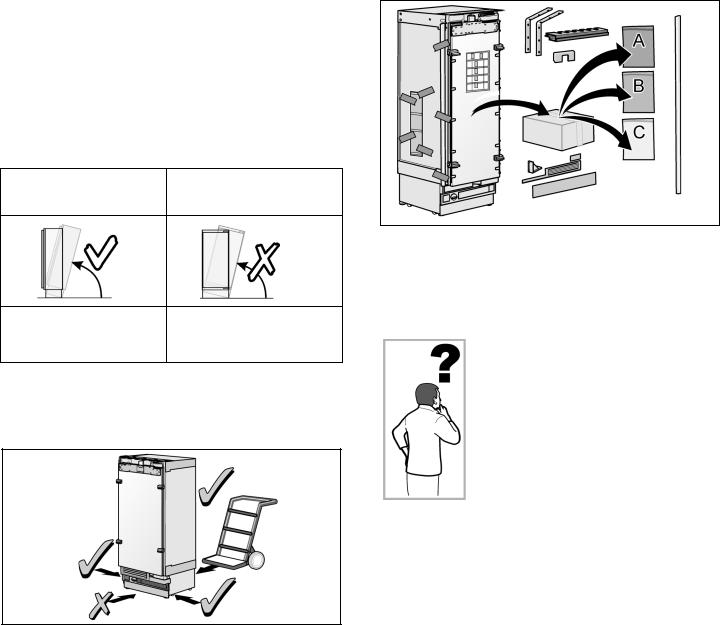
3.Transport of the appliance
, WARNING
Be careful, otherwise people who are helping may be injured or the appliance may be damaged.
The appliance is very heavy.
The appliance is 83 1/8" (2126 mm) tall. If the appliance cannot be transported in an upright position,
the appliance can be transported horizontally.
Note:
Do not raise up the appliance via the side panels. Risk of damage to the appliance!
When raising up the appliance, observe the required minimum height at the installation location according to the following table:
Raise up via |
Do not raise up from |
appliance rear |
appliance side |
Minimum height |
Do not raise up the |
|
appliance via the side |
||
86"/2185 mm |
||
panels! |
||
|
Note:
Always use the appliance dolly from the rear side of the appliance. Never push it in from the front under the appliance. Risk of damage to the appliance!
1.Transport the appliance to a suitable installation location with suitable means of transportation (trolley, lifting truck or hand).
2.Secure the appliance during transportation to prevent it from tipping.
4.Installation preparation
Unpack installation materials and accessories.
To simplify installation, the packages are identified with labels A, B and C corresponding with the manual sections.
5.Special installation
The following symbol indicates that additional steps need to be taken before proceeding to the next chapter.
Special installation steps are described after section C.
Change over door hinge, see “Changing over the door hinges”.
Sealing mat, see “Removing/ changing over the sealing mat”
Side-by-Side installation, see “Side- by-Side installation”.
Connecting the water, see “Preparing to connect the water” an “Connecting the water to the appliance”.
Ice-water dispenser, see “Aligning the ice-water dispenser“.
Cover strips for a wine unit, see “Attaching the cover strips”
Door limitation pin, see “Adjusting the door opening angle”.
12

1.Attaching the anti-tip-brackets
,WARNING:
Risk of injury and damage!
Assure that there are no electrical wires or plumbing in the area which the screws could penetrate.
,WARNING:
Risk of injury! Always wear safety glasses and other necessary protective devices or apparel when installing or working with dowels.
Important note:
If a Side-by-Side set up of two appliances is envisaged, the anti-tip brackets are needed as installation aid. Connect the appliances before the anti-tip brackets are fixed to the wall, see “Side-by-Side installation”.
Note:
2 anti-tip-brackets are required for each appliance.
The supplied set contains fastening screws for various applications. Select the fastening screws according to the local conditions.
If the anti-tip brackets, and therefore the appliance, cannot be securely attached with the supplied fastening screws, another suitable method must be used to attach the appliance securely.
The anti-tip-brackets (a) must overlap a minimum of 21/8” (54 mm) over the appliance to secure the appliance.
If this minimum length cannot be observed for structural conditions it is possible to do this by fastening
a spacer (b) behind the anti-tip angle, e.g. a sufficiently dimensioned wood board.
The length of the plank should correspond to the width of the installation niche!
1.Specify the attachment points of the anti-tip-brackets according to the section on “Dimensions of the installation niche”.
2.Attach the anti-tip-brackets completely. Be sure screws hold tight.
Important notes for fastening with dowels and screws:
Not recommended for use in light-weight masonry material such as cinder block.
Not recommended for use in new concrete which has not had time to cure.
13
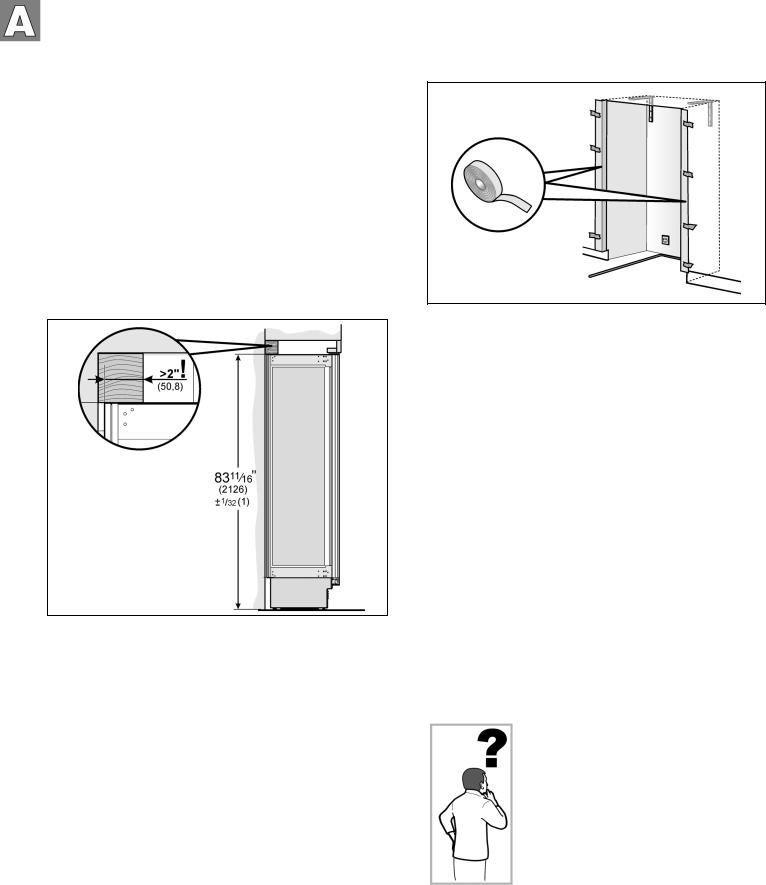
2.Attaching an alternative anti-tip device
Important note:
If the anti-tip brackets cannot be attached securely,
an alternative anti-tip-device can be attached. However, ensure that there is no play between the appliance and the anti-tip-device. If possible, always screw the wooden beam to existing studs on the rear panel of the installation niche.
1.Saw the wooden beam (cross section min. 3" x 4") to the required length. Length is equal to the width of the installation niche!
Note:
If the installation niche is deeper than the appliance, select a beam which has a larger cross section or attach 2 beams.
The beam must cover the appliance by at least 2" (50.8 mm).
2.Mark the installation height (lower edge of the beam) on the rear panel of the installation niche.
3.Select screws according to the thickness of the wooden beam: length = min. 2.5 x beam thickness, diameter #12 or #14.
Note:
Choose the number of screws according to the installation niche width, thereby ensuring that the beam can be attached securely.
4.Depending to the subsurface:
Locate wall studs in the rear of the installation niche and accordingly transfer their location to the wooden beam
or
fasten suitable dowel into the rear wall.
5.Predrill the wooden beam.
6.Attach the wooden beam to the rear panel of the installation niche.
3.Attaching an edge protection
To protect the edges of the installation niche, it is recommended to attach edge protection made of a suitable material.
The following are special installation steps. Instructions are provided after section C.
Change over door hinge, see “Changing over the door hinges”.
Sealing mat, see “Removing/ changing over the sealing mat”
Side-by-Side installation, see “Side- by-Side installation”.
Connecting the water, see “Preparing to connect the water”.
14
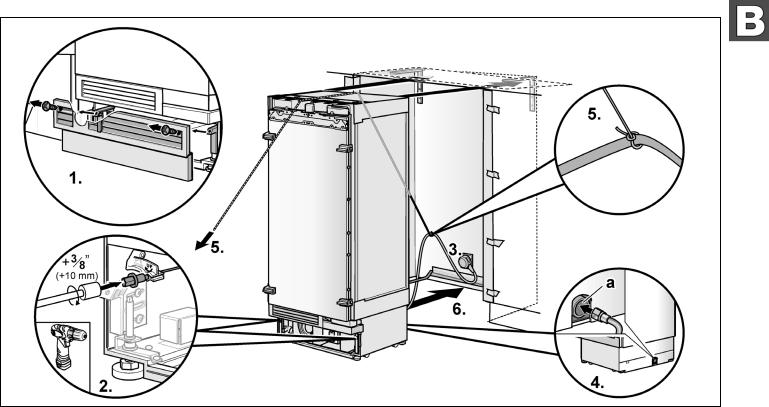
1.Pushing the appliance into the installation niche
,CAUTION
Caution when pushing the appliance into the installation niche. Do not damage the water line or power cord.
Note:
When the floor or the appliance is not leveled in comparison to the installation niche adjust height adjustable wheels before you move the appliance into the installation niche.
1.Remove the base panel.
2.Raise the height-adjustable wheels at the back by approx. 3/8" (10 mm).
3.Put the electric plug into the socket.
4.Push the water line into the guard tube (a) at the rear of the appliance.
,WARNING
Be careful, otherwise people who are helping may be injured or the appliance may be damaged.
The appliance may tip over while the water line is pushing into the guard tube (a).
5.To prevent the power cord from becoming caught, tie a piece of string to the middle of the power cord and feed forwards over the top of the appliance.
When pushing in the appliance, pull the cable upwards. Take care not to pinch the power cord. or
Using adhesive tape, tape the power cord to the floor centrally behind the appliance approx.
15" (380 mm) away from the rear panel of the installation niche.
6.Carefully push the appliance into the installation niche.
7.Remove edge protection (if attached).
15
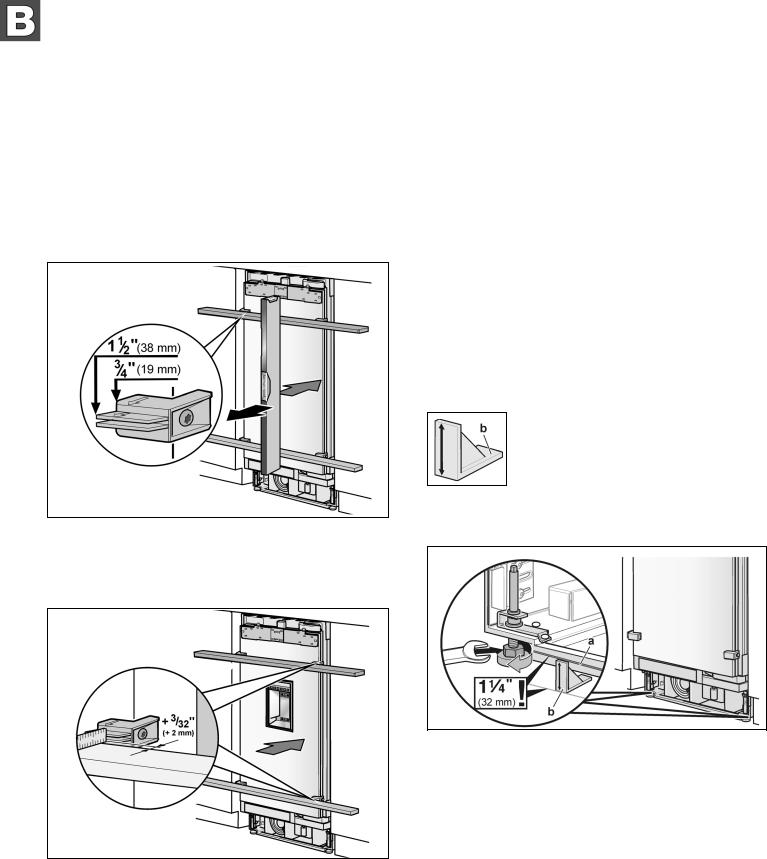
2.Aligning the appliance in the installation niche
Note:
To ensure that the appliance functions correctly, it must be set perfectly levelled.
Depth alignment
The positioning aid on the door have been designed for the following total thickness of door panels:
3/4" (19 mm)
11/2" (38 mm)
Always take account of the possible differing thickness of the panel fronts which are to be fitted subsequently.
1.Align the appliance with the cabinet fronts using the positioning aid.
Place level over the positioning aid on the door.
For freezer unit with ice-water dispenser:
Freezer units with ice-water dispenser have to be set back an additional 3/32” (min. 2 mm) between front of positioning aids and cabinet.
This is also the case for other units if they are combined with an IWD unit in a side-by-side installation.
Height alignment
Notes:
Do not twist or jam the appliance inside the installation niche! When adjusting the heightadjustable feet, proceed gradually: Always alternate between left and right, etc.
For easier adjustment of the rear feet take the weight off by slightly tilting the appliance forward.
When using a wooden beam as an alternative antitip mechanism, turn the appliance as far as it will go against the wooden beam. Do not bend against the wooden beam.
The height-adjustable feet at the front and rear can all be adjusted from the front.
Front: |
with open-ended wrench 1/2" |
|
|
(Width across flats 13 mm) |
|
Rear: |
with 5/ " (8 mm) hex nut driver via flexible |
|
|
shaft. |
16 |
|
|
|
The mark (a) attached at the appliance base is used as a standard gage for height adjustment. When adjusting the height, align this mark at a height of 11/2" (32 mm) above the floor.
It is very important to comply with this dimension for the subsequent alignment of the furniture fronts.
The height adjustment gauge (b) is used to set this height correctly. The upper edge of the gauge must be in alignment with the mark on the appliance.
2.Unscrew the feet at the front of the appliance until the mark (a) on the appliance is in alignment with the upper edge of the height adjustment gauge (b).
16

3.Align the appliance vertically using the feet at the back. Use a level!
Note:
In the case of a Side-by-Side installation this installation step is not possible. These parts have been removed.
3.Attaching the appliance to the installation niche
It is essential to attach the appliance to the top of the installation niche.
1.Screw the attachment plate lugs (top) to the overhead furniture.
2.If there is a fairly large gap above the appliance, fit a wooden beam above the appliance, ensuring that the wooden beam fits the gap exactly.
3.If there is enough room on the top of the appliance, fix the attachment plate side lugs (top) to the side of the niche.
4.Screw on the bars of the fastening sheets (lateral) with the cabinet parts located next to them.
5.Shorten the fitting strip (a) to the required height to fill the gap.
6.Press fitting strip (a) into the cover strip (b).
7.Attach the cover strip (b) to the attachment plate (top).
Note:
In the case of a side-by-side installation connect both cover rails to the bolt included in the installation accessories for side-by-side installation.
The following is a special installation step. Instructions are provided after section C.
Connecting the water, see “Connecting the water to the appliance”.
17

1.Attaching the toe kick panel
Note:
Risk of damage to the appliance. Do not cover ventilation slots in the base panel.
Nominal dimensions to be observed:
Stainless steel panel (accessory)
1.Attach the base panel to the appliance (do not screw on).
2.Remove the protective film from the adhesive pads.
3.Fit the toe kick panel to the base panel and press firmly into place.
Wooden panel
1.If required, shorten wooden panel to the required length.
2.Screw wooden panel to the base panel from behind. There are already screw holes in the base panel.
2.Aligning the base panel
1.Put on the base panel (do not screw on) and measure the difference in depth A between the base panel and toe kick panel of the adjacent cabinet.
2.Remove the base panel.
3.Adjust the brackets (a) to the dimensions A and tighten.
4.Attach the base panel.
18

3.Switching the appliance ON
To guarantee the accuracy of the following working steps and thus the appearance of the overall kitchen front later on, the appliance should now be operated.
1.Open the appliance door.
2.Press the POWER button.
3.Press the POWER button again to shut off.
Only for appliances with a water connection:
In order to avoid the risk of damage caused by leaking water from damage possibly caused to the water pipe feeding the appliance, keep the shut-off valve closed.
4.Preparing the door panels
Important note:
When performing any work on the door panels, always observe the following:
Always screw into the best load-bearing material of the door panel.
Never screw into fillers, decorative strips or similar.
Select a screw length which is always shorter than the thickness of the door panel.
To prevent damage, protect surfaces of the door panels during installation.
The total weight of the door panel must not exceed the following values:
|
18" Appliance |
44 |
Ibs/20 kg (19 lbs/8.5 kg *) |
|
24" Appliance |
55 Ibs/25 kg (32 lbs/14.5 kg *) |
|
|
30" Appliance |
64 |
Ibs/29 kg |
(* Wine unit)
Important information for furniture doors with cutout (appliances with ice and water dispenser, wine storage cabinets):
The cut edges of the door cutout must be protected before humidity penetrates. To do this, use the means suitable for the material and the shape of the furniture door (e. g. edge veneer, edge sealant).
5.Loading the appliance door
When attaching the door panels, it is recommended to load the door storage compartments in the appliance with weights in order to ensure that the gap width is as precise as possible.
Recommendations:
|
18" Appliance: |
22 lbs/10 kg |
|
24" Appliance: |
33 lbs/15 kg |
|
30" Appliance: |
44 lbs/20 kg |
|
|
|
|
|
|
6.Removing the installation support part
Unscrew the positioning aid from the appliance door.
Note:
Store the positioning aids, there will be used in an installation step later.
19
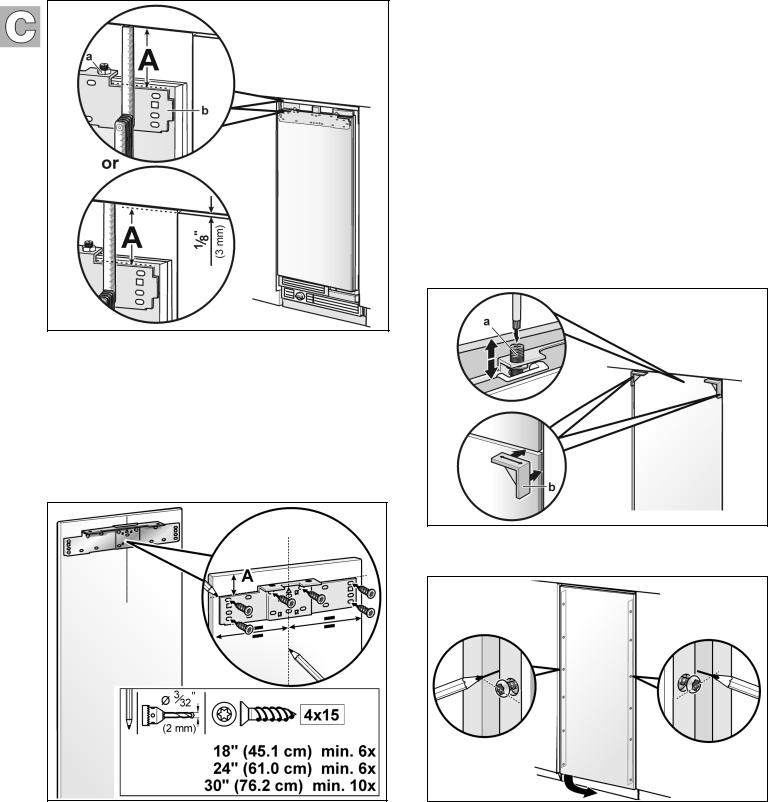
7.Attaching the adjusting rail to the door panel
1.Measure the distance A between the adjusting rail and the overhead cabinet/fixtures.
2.Loosen the 2 nuts (a) and remove the adjusting rail (b).
3.Mark this amount A on the rear of the door panel.
4.Determine and mark the centerline of the door panel.
5.Put on the adjusting rail and align along the marks. Mark the drill holes.
6.Drill the holes.
7.Screw on the adjusting rail tightly.
Notes:
Attach the adjusting rail to the door panel with at least 10 screws. One screw should be inserted under each double threaded bolt.
The adjusting rail features a variety of holes for the many different design options of door panels. Always screw into the best load-bearing material of the door panel.
8.Attaching the fixation strips to the door panel
Note:
The fixation strips are pre-assembled for stainless steel doors. In this case continue with the next installation step (“C / 9. Attaching the door panel”).
1.Hang the door panel on the double threaded bolt (a).
2.Align the door panel with the double threaded bolts (Torx screwdriver).
Re-examine the dimensions of the gap continuously. Use the height adjustment gauge (b).
3.Transfer the middle drill holes along the outer edge of the appliance door to the door panel and mark.
4.Remove the door panel.
20

5.Using the positioning aid, mark the vertical sides of the door panel parallel.
6.Using a square, extend the drill hole marks which you have just made to the vertical marks.
7.Apply the fixation strip and mark out the holes.
8.Pre-drill the holes.
9.Screw on the fixation strips.
9.Attaching the door panel
Note:
Now attach the furniture handles which are screwed from behind!
1.Remove the fixing brackets (a) from the appliance door. To do this, loosen the bracket screws (b) only.
2.Insert removed fixing brackets (a) into the adjusting rails (b) on the door panel.
3.Open the appliance door.
21

4.Hang the door panel with adjusting rail over the double threaded bolts.
5.Lower door panel and push the fixing brackets down over the fastening screws.
10.Screw nuts onto the double threaded bolts and tighten. This will fix the side alignment of the door.
6.Adjust the door panel using the double threaded bolts (Torx screwdriver). Re-examine the dimensions of the gap continuously.
7.Close the door and check that the depth of the door panel is aligned with the adjacent fronts.
If required, correct.
8.Tighten the bracket screws to fix the depth alignment.
9.Close the door and check the side alignment. Correct by gently tapping the edge of the open door panel with your hand.
10. Attaching the lower bracket
The lower bracket fixes the side position of the door. The number of lower brackets depends on the width and the design of the door panel.
Screw on the lower brackets (Installation kit). Predrill holes in the door panel!
1.Loosen the screw.
2.Push the bracket over the screw.
3.Check the side position of the door.
4.Screw in the screw.
5.Tighten the screw.
6.Put the cover on the brackets.
22
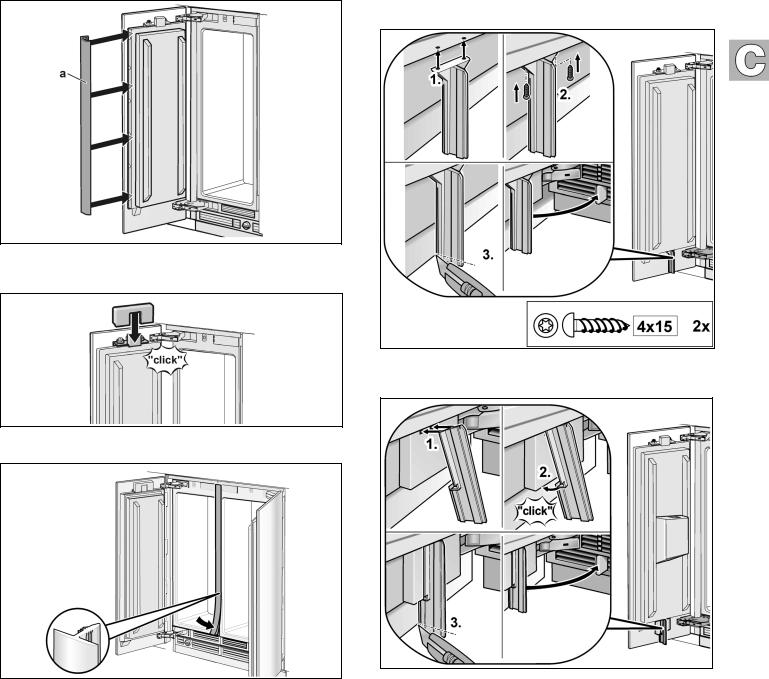
11. Attaching the strips
1.Attach the cover strip (a) on the door.
2.Attach the light switch cover.
The cover can be screwed to the door.
Side-by-Side installation only:
Insert the cover strip into the space between the appliances.
The cover rail is included in the installation accessories for side-by-side installation.
12. Mounting the air seperator
Using the air seperator, air which is supplied and drawn from the appliance is fed seperately, in order to avoid reduced operating capacity.
Only in the case of freezers with ice and water dispenser:
23
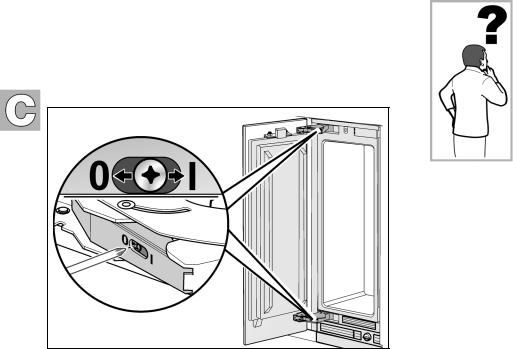
13. Adjusting the door spring
Rotate the adjusting screw with a cross-head screwdriver.
I = maximum spring tension 0 = no spring tension
The following are special installation steps. Instructions are provided after section C.
Ice-water dispenser, see “Aligning the ice-water dispenser“.
Cover strips for a wine unit, see “Attaching the cover strips”
Door limitation pin, see “Adjusting the door opening angle”.
Installation of the appliance is now complete.
24
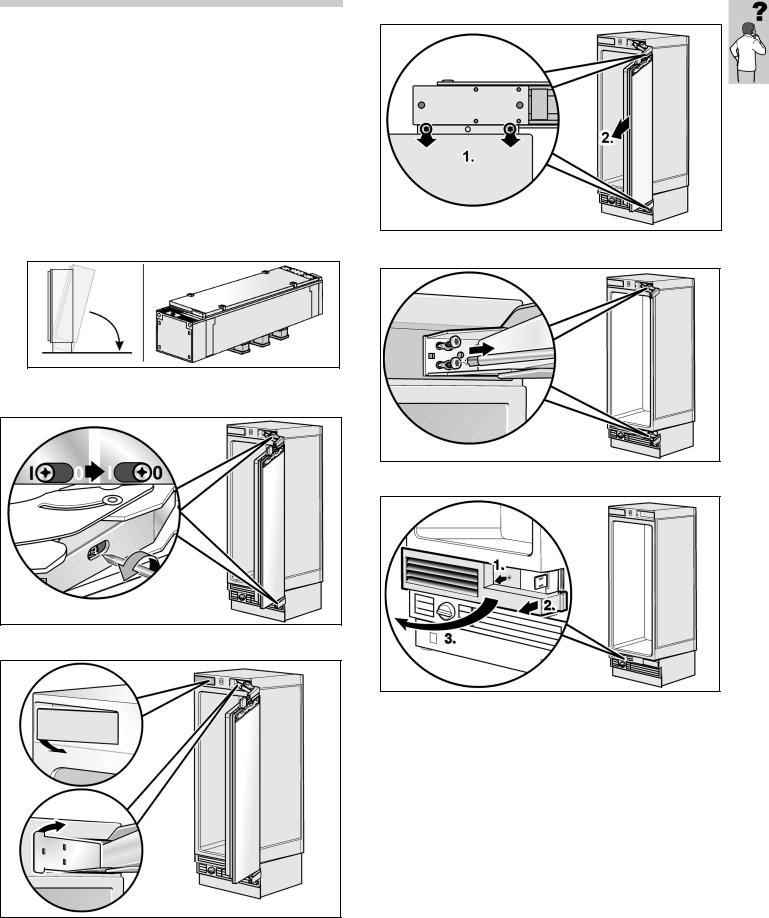
Special installation
Changing over the door hinges
,WARNING:
Risk of injury!
Before working on the hinge, release the spring.
Note:
The door hinges cannot be exchanged in the case of freezers with ice and water dispensers.
Switching the door hinge is made easier if the appliance is stored here on the back (put the pallet underneath).
1.Release the spring on the hinge. Loosen the screw from I to 0.
2.Remove the hinge box covers.
3.Unscrew (1.) and remove (2.) the door.
4.Remove the hinges.
5.Remove the ventilation grille.
25
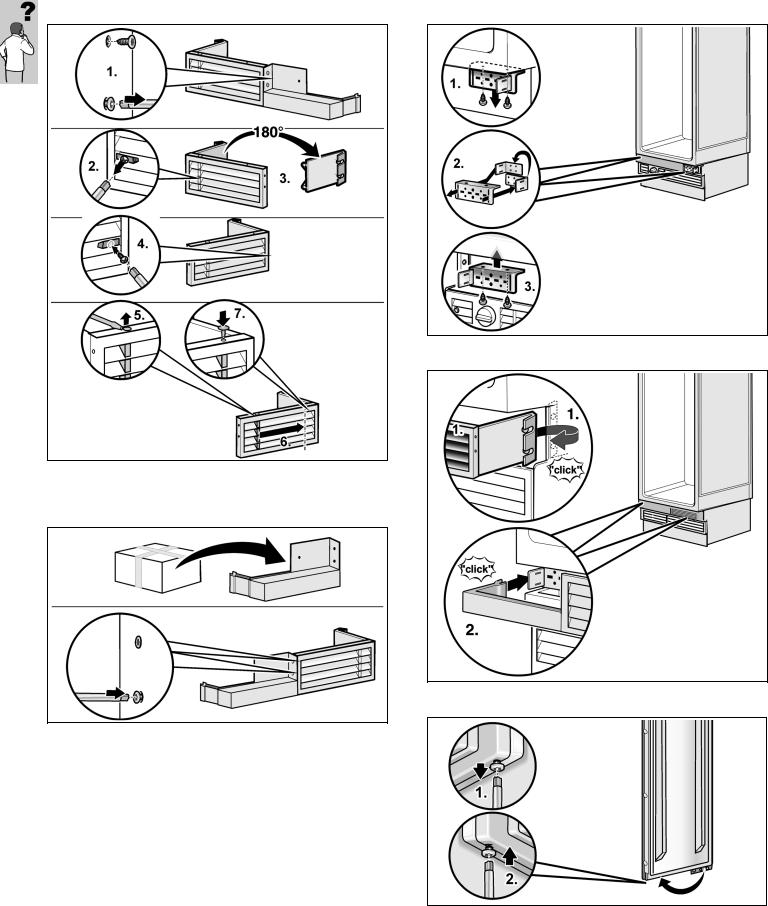
6.Mount new the ventilation grill.
A replacement part for the ventilation grille to adapt to the modified door hinge is included in the installation materials and accessories.
7.Change over the hinge angle.
8.Attach the ventilation grille.
9.Change over the screw for the lower bracket.
26
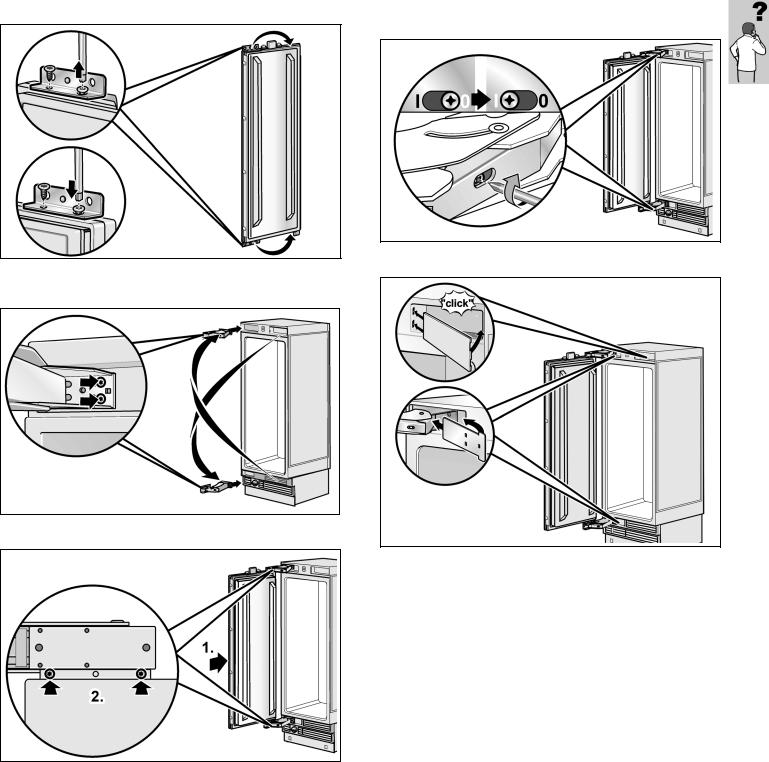
10. Change over the fixation parts on the door.
11.Fix the hinges on the appliance. Change the hinges crosswise!
12. Fix the door.
13.Span the spring on the hinge. Tighten the screw from 0 to I.
14. Fix the hinge box cover.
27
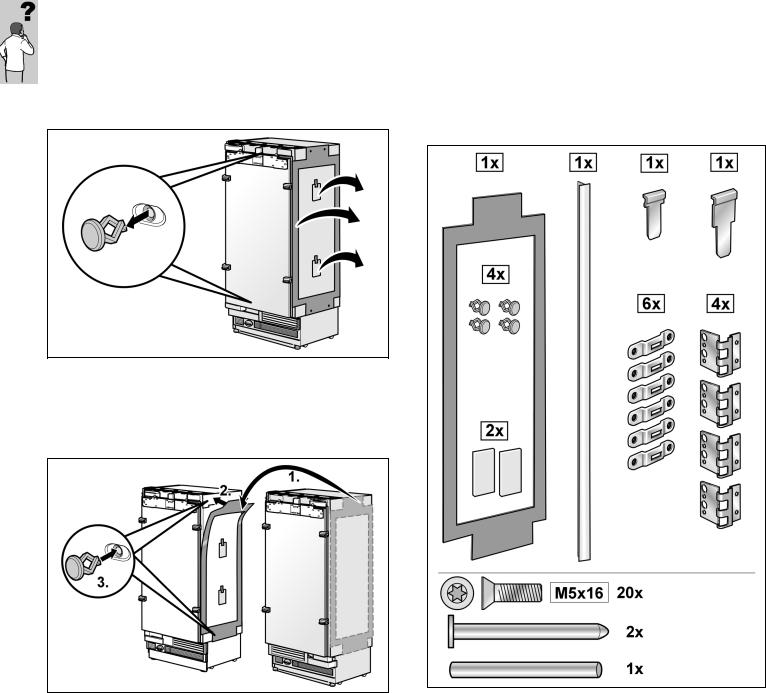
Removing/changing over the sealing mat
Freezers are fitted with a sealing mat at the factory for side-by-side installation.
If a single appliance is installed, the sealing mat is not required and can be removed.
The sealing mat is essential for side-by-side installation.
If the door hinges were fitted to the other side of the door, the sealing mat must be attached to the other appliance. Always attach sealing mat to the right side of the appliance situated on the left.
Side-by-Side installation
If a Side-by-Side installation is intended, now connect the two appliances together.
1.Unpack the Side-by-Side kit and check that no parts are missing.
Keep ready the anti-tip brackets as an installation aid.
2.Place the appliances next to each other in the intended configuration.
28

3.Unscrew the base panels.
Notes:
Freezers are factory equipped with a sealing mat for the Side-by-side installation.
Continues the work to step 6.
Attach the mat always left standing appliance!
4.Place sealing mat on the appliance and secure with the attachment pins.
5.Place the water-absorbing stripes from the Side-by- Side kit on the side wall and secure with self adhesive tape.
6.Screw side plates from the Side-by-Side kit to both appliances. Note the position of both appliances!
7.Screw the hinge halves in the Side-by-Side kit to both appliances.
29
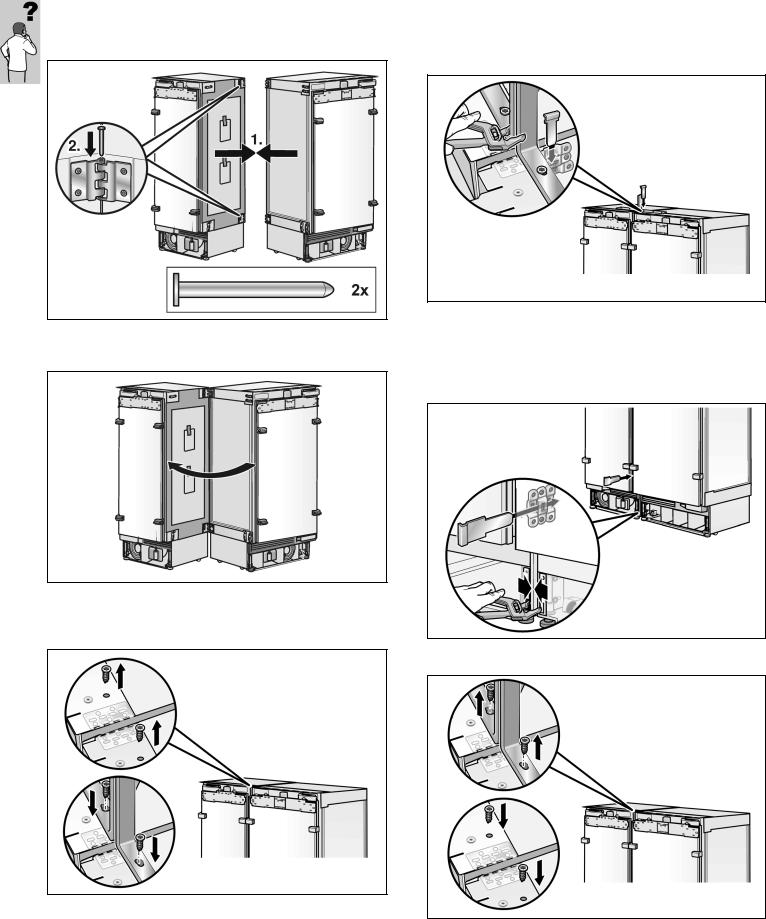
8.Push the appliances together until the hinge halves interlock.
9.Insert pins into the hinges.
10.Push the appliances together at the front as far as possible.
11.Loosen the screws on the top of the appliance and in their place screw on the anti-tip brackets as installation aid.
12.Pull the appliances together at the top with Water pump pliers (A).
13.When the appliances have been completely pulled together, insert the bar into the upper plates.
14.Pull the appliances together at the bottom with Water pump pliers.
15.When the appliances have been completely pulled together, insert the bar into the lower plates.
Use a tool to push the bar in all the way.
16. Remove the installation aids.
30
